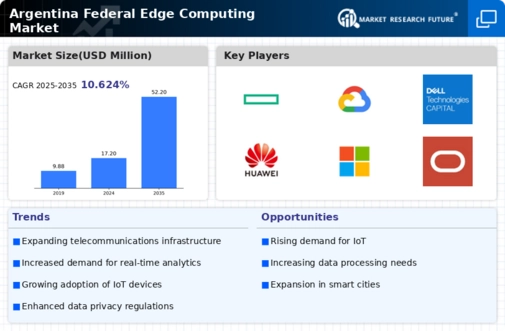Enhanced Security Requirements
Security concerns remain a pivotal driver for the federal edge-computing market in Argentina. With the rise of cyber threats, government entities are compelled to adopt edge computing solutions that offer improved data protection. By processing sensitive information closer to the source, agencies can mitigate risks associated with data breaches and unauthorized access. The federal edge-computing market is likely to see an increase in investments aimed at fortifying cybersecurity measures, with projections suggesting that spending on security solutions could reach $1 billion by 2026. This focus on security not only safeguards critical data but also fosters trust in digital transformation initiatives.
Government Initiatives and Funding
Government initiatives play a significant role in shaping the federal edge-computing market in Argentina. The Argentine government has recognized the potential of edge computing to enhance public services and has initiated various funding programs to support its adoption. These initiatives aim to modernize infrastructure and improve service delivery across sectors such as transportation, healthcare, and education. As a result, the federal edge-computing market is expected to benefit from increased public sector investment, with estimates indicating that government spending on technology could rise by 15% annually. This financial backing is likely to accelerate the deployment of edge computing solutions.
Growing Adoption of Smart City Projects
The federal edge-computing market in Argentina is significantly influenced by the growing adoption of smart city projects. As urban areas expand, the need for efficient management of resources and services becomes paramount. Edge computing facilitates the integration of IoT devices, enabling real-time monitoring and control of urban infrastructure. This trend is expected to drive the federal edge-computing market, with investments in smart city technologies projected to exceed $500 million by 2027. The implementation of these projects not only enhances urban living but also positions Argentina as a leader in innovative technology solutions.
Increased Collaboration with Private Sector
Collaboration between government agencies and private sector companies is emerging as a key driver for the federal edge-computing market in Argentina. Such partnerships enable the sharing of expertise and resources, fostering innovation in edge computing solutions. Private companies are increasingly providing advanced technologies and services that complement government initiatives. This collaborative approach is likely to enhance the efficiency and effectiveness of public services, with projections indicating that joint ventures could lead to a 20% increase in the adoption of edge computing technologies. The synergy between public and private sectors is essential for the growth of the federal edge-computing market.
Rising Demand for Real-Time Data Processing
The federal edge-computing market in Argentina experiences a notable surge in demand for real-time data processing capabilities. This trend is driven by the increasing need for immediate insights in various sectors, including defense, public safety, and healthcare. As government agencies seek to enhance operational efficiency, the ability to process data at the edge becomes crucial. Reports indicate that the market for edge computing solutions is projected to grow at a CAGR of approximately 25% over the next five years. This growth reflects the urgency for timely decision-making and the optimization of resources, thereby propelling the federal edge-computing market forward.

















Leave a Comment